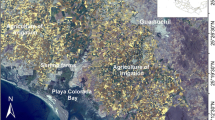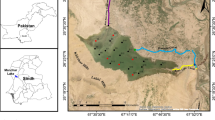Abstract
This study focuses on utilizing satellite remote sensing to monitor the water clarity of Lake Simcoe, Ontario, Canada, which has been suffering from the overload of phosphorus (TP) and therefore eutrophication for decades. The dataset includes 22 cloud-free Landsat-5 Thematic Mapper (TM) images, as well as the nearly simultaneous in-situ observations from 15 stations on the lake. Compared to the general model used to estimate the Secchi Disk Transparency (SDT), a parameter for water clarity measurements, an improved model is developed, from the TM images. The results of these estimations are validated using the in-situ data by linear regression, and the accuracies are measured by the coefficient of determination R 2. The results reveal an indication of high model fit between the majority of SDT predictions and the in-situ observations. Also, the improved SDT model provides higher prediction accuracies than the general one when applied to 68.2% (15 out of 22) of the images. The estimated clarity maps indicate that the turbid water is normally distributed at the nearshore areas and the northeastern region. Meanwhile, the southwestern lake has much clearer water than the other regions. In addition, the southern bay has always been suffering from a serious water quality problem even till now. The water clarity of Lake Simcoe shows strong seasonal patterns, that it is at its worst in August and September annually and much better in the other sampling seasons. On an overall scale, the lake water clarity kept relatively stable from 1987 until the fall of 1992, followed by a gradual increase until 2000, after a slight decrease, and lastly stayed consistent until the summer of 2008.
Similar content being viewed by others
References
Brezonik PL, Kloiber SM, Olmanson LG, Bauer ME (2002) Satellite and GIS tools to assess lake quality. Technical Report 145, Water Resources Center, University of Minnesota
Brezonik PL, Olmanson LG, Bauer ME, Kloiber SM (2007) Measuring water clarity and quality in Minnesota lakes and rivers: a census-based approach using remote-sensing techniques. Cura Reporter, Water Resources Center, University of Minnesota, St Paul
Brown D, Warwick R, Skaggs R (1977) Reconnaissance analysis of lake condition in east-central Minnesota. Report No. 5022. Minnesota Land Management Information System, Center for Urban and Regional Affairs, University of Minnesota, Minneapolis
Carlson RE, Simpson J (1996) A coordinator’s guide to Volunteer Lake monitoring methods. North American Lake Management Society, Madison, Wisconsin. http://www.secchidipin.org/eutrophication_SD.htm. Accessed 26 January 2011
Carpenter SR, Caraco NF, Correll DL, Howarth RW, Sharpley AN, Smith VH (1998) Nonpoint pollution of surface waters with phosphorus and nitrogen. Ecol Appl 8:559–568
Chambers PA, Guy M, Roberts ES, Charlton MN, Kent R, Gagnon C, Grove G, Foster N (2001) Nutrients and their impact on the Canadian environment, Agriculture and Agri-Food Canada, Environment Canada, Fisheries and Oceans Canada, Health Canada and Natural Resource Canada
Choubey VK (1994) Monitoring water quality in reservoirs with IRS-1A-LISS-I. Water Resour Manage 8:121–136
Cox RM, Forsythe RD, Vaughan GE, Olmsted LL (1998) Assessing water quality in the Catawba River reservoirs using Landsat Thematic Mapper satellite data. Lake Reserv Manage 14:405–416
Environment Canada (2009) Cleaning up Lake Simcoe: Part of the Government of Canada’s Action Plan for Clean Water. http://www.ec.gc.ca/paae-apcw/Default.asp?lang=En&n=63494C3C-1. Accessed 26 January 2011
Environment News Service (2008) Canada opens CAN$30m fund to clean popular vacation lake. http://www.environmental-expert.com/resultEachPressRelease.aspx?cid=4797&codi=34211. Accessed 26 January 2011
Giardino C, Pepe M, Brivio PA, Ghezzi P, Zilioli E (2001) Detecting chlorophyll, Secchi disk depth and surface temperature in a sub-alpine lake using Landsat imagery. Sci Total Environ 268:19–29
Giardino C, Brando VE, Dekker AG, Strmbeck N, Candiani G (2007) Assessment of water quality in Lake Garda (Italy) using Hyperion. Remote Sens Environ 109:183–195
Giardino C, Bresciani M, Villa P, Martinelli A (2010) Application of remote sensing in water resource management: the case study of Lake Trasimeno, Italy. Water Resour Manage 24:3885–3899
Henderson-Sellers B, Markland HR (1987) Decaying lakes. Wiley, Chichester
Johnson MG, Nicholls KH (1989) Temporal and spatial variability in sediment and phosphorus loads to Lake Simcoe, Ontario. J Great Lakes Res 15:265–282
Kaw A, Kalu E (2008) Numerical Methods with Applications, lulu.com
Kiage LM, Walker ND (2009) Using NDVI from MODIS to Monitor Duckweed Bloom in Lake Maracaibo, Venezuela. Water Resour Manage 23:1125–1135
Kloiber SM, Brezonik PL, Olmanson LG, Bauer ME (2002a) A procedure for regional lake water clarity assessment using Landsat multispectral data. Remote Sens Environ 82:38–47
Kloiber SM, Brezonik PL, Bauer ME (2002b) Application of Landsat imagery to regional-scale assessments of lake clarity. Water Res 36:4330–4340
Kondratyev KY, Pozdnyakov DV, Pettersson LH (1998) Water quality remote sensing in the visible spectrum. Int J Remote Sens 19:957–979
Lathrop RG (1992) Landsat Thematic Mapper monitoring of turbid inland water quality. Photogramm Eng Remote Sens 58:465–470
Lathrop RG, Lillesand TM (1986) Utility of Thematic Mapper data to assess water quality. Photogramm Eng Remote Sens 52:671–680
Lillesand TM, Johnson WL, Deuell RL, Lindstrom OM, Meisner DE (1983) Use of Landsat data to predict the trophic state of Minnesota lakes. Photogramm Eng Remote Sens 49:219–229
Lu Q, Duckett F, Nairn R, Brunton A (2006) 3-D eutrophication modeling for Lake Simcoe, Canada. In: American Geophysical Union 2006 Fall Meeting, 11–15 December 2006. San Francisco, CA
Mendoza ME, Bocco G, Bravo M, Granados EL, Osterkamp WR (2006) Predicting water-surface fluctuation of continental lakes: a RS and GIS based approach in Central Mexico. Water Resour Manage 20:291–311
Nelson SAC, Soranno PA, Cheruvelil KS, Batzli SA, Skole DL (2003) Regional assessment of lake water clarity using satellite remote sensing. Residence time in lakes: science, management, education. J Limnol 62(1):27–32
Nicholls KH (1997) A limnogolical basis for a Lake Simcoe phosphorus loading objective. Lake Reserv Manage 13:189–198
Olmanson LG, Bauer ME, Brezonik PL (2008) A 20-year Landsat water clarity census of Minnesota’s 10,000 lakes. Remote Sens Environ 112:4086–4097
RummelBrezonik PL, Kloiber S RJ (1976) Understanding correlation. http://www.hawaii.edu/powerkills/UC.HTM. Accessed 26 January 2011
Smith VH (1998) Limitations, and frontiers in ecosystem ecology. Springer, New York
Stadelmann TH, Brezonik PL, Kloiber S (2001) Seasonal patterns of chlorophyll a and Secchi Disk Transparency in lakes of East-Central Minnesota: implications for design of ground- and satellite-based monitoring programs. Journal of Lake and Reservoir Management 17:299–314
Winter JG, Walters M, Willox C (2005) Scientifically derived phosphorus loading objective and adaptive watershed management for Lake Simcoe, Canada. In: 53rd Joint Meeting of American Geophysical Union, 23–27 May, Louisiana
Winter JG, Eimers MC, Dillon PJ, Scott LD, Scheider WA, Willox CC (2007) Phosphorus inputs to Lake Simcoe from 1990 to 2003: declines in tributary loads and observations on lake water quality. J Great Lakes Res 33:381–396
Wu G, de Leeuw J, Liu Y (2009) Understanding seasonal water clarity dynamics of Lake Dahuchi from in situ and remote sensing data. Water Resour Manage 23:1849–1861
Author information
Authors and Affiliations
Corresponding author
Rights and permissions
About this article
Cite this article
Guan, X., Li, J. & Booty, W.G. Monitoring Lake Simcoe Water Clarity Using Landsat-5 TM Images. Water Resour Manage 25, 2015–2033 (2011). https://doi.org/10.1007/s11269-011-9792-3
Received:
Accepted:
Published:
Issue Date:
DOI: https://doi.org/10.1007/s11269-011-9792-3




